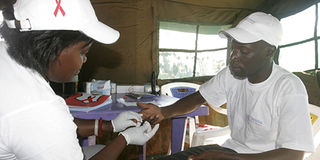Aids infections on the decline

HCT Counsellor Linet Okore of LVCT takes a blood sample as she provided HCT (HIV Testing & counselling) to Daniel Ombech Sule, a boda boda operator in Kondele, during a pre-world aids day where HTC, condom distribution, demonstration on condom usage and sensitisation were offered to the public on Monday ahead of World Aids Day that will be celebrated internationally on 1st December. Photo/TOM OTIENO
What you need to know:
- Kenya wins UN praise and wants to put more people on antiretroviral drugs
Emerging evidence indicates current HIV interventions are saving lives and slowing the rate of new infections in Kenya and several other countries.
Buoyed by this development, the country plans to scale up the number of people on antiretroviral drugs from 300,000 to 480, 000 within the next two years.
According to the UN data released last week, ahead of the World Aids Day being marked Tuesday, Kenya is among a handful of countries that have reduced the number of Aids related deaths by as much as 25 per cent in the last eight years.
The UN study also says prevention programmes also seems to be working having managed to stabilize the rate of new infections.
However on Monday groups involved in Aids related activities, doubted whether the country has the capacity to scale up antiretroviral targets or even maintain the current prevention momentum because of a looming funding crisis.
A crucial $270 million funding application was recently turned down by a Global Fund for Aids TB and Malaria technical committee prompting the country to appeal to the fund’s board of directors.
The country has now been told to revise the proposal and reapply, a process which could delay funds for almost a year.
Because of this and other financial delay and spats with donors a report released yesterday by the Kenya Aids NGOs Consortium (KANCO) says the country is unlikely to meet set HIV targets.
The Kenya National AIDS Strategic Plan targets to reduce new HIV infections by 50 per cent in the next five years.
The KANCO report says Kenya has so far lost Sh3.8 billion in donor money meant for HIV/Aids programmes released from the Global Fund since 2002.
Another grant of Sh9.7 billion meant for Round 7 funding is yet to be released because of the country’s ‘‘poor absorption capacity and reporting’’.
“We are not coordinated and this is the reason we have continued to lose money,” said KANCO executive director, Allan Ragi. “We should stop this blame game that refuses to shed light on accountability especially at the executive level.”
Living longer
Meanwhile, an estimated 33.4 million people worldwide are infected with the AIDS virus, up from 33 million in 2007, but more people are living longer due to the availability of drugs, according to a UN report.
However, more than half of the people who need life-saving drugs are not getting them, according to the 2009 Aids epidemic update launched on Tuesday in Shanghai by the World Health Organisation and Joint UN Program on HIV/AIDS (UNAids).
Cocktails of drugs can control HIV but there is no cure.
UNAids executive director Michel Sidibe told Reuters in an interview in Shanghai that advances in HIV prevention and treatment were still very lopsided.
Additional reporting by Reuters




